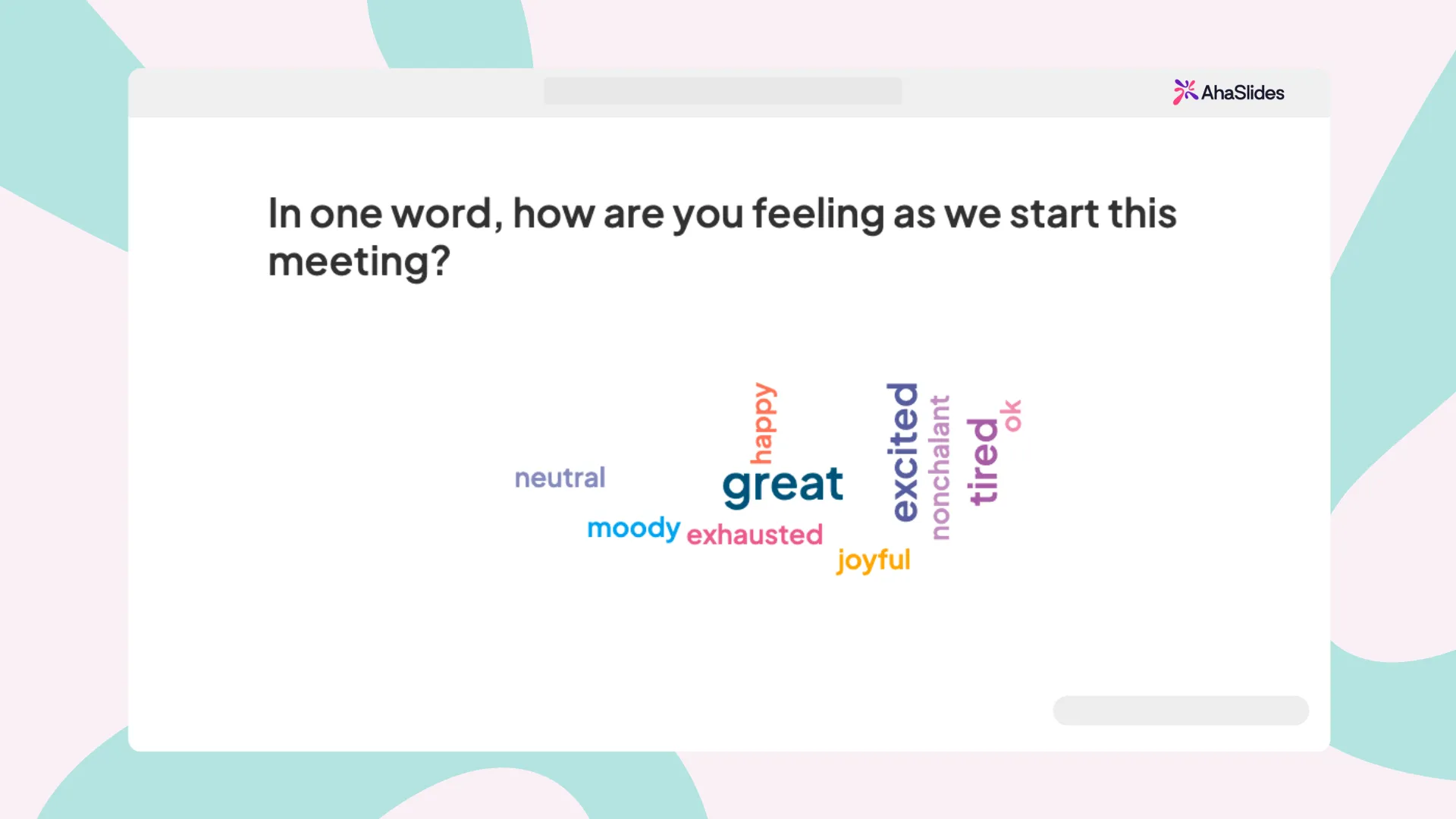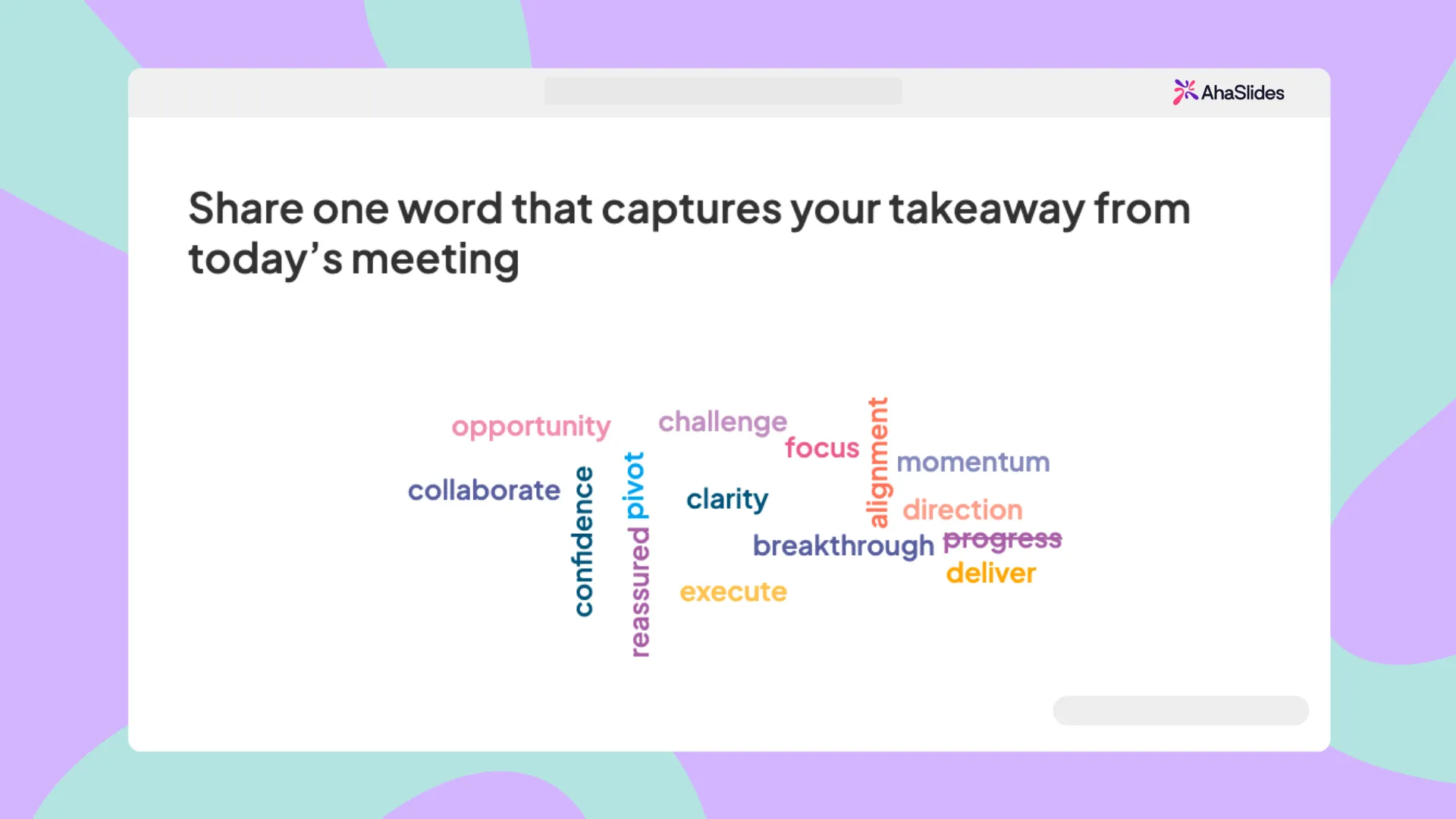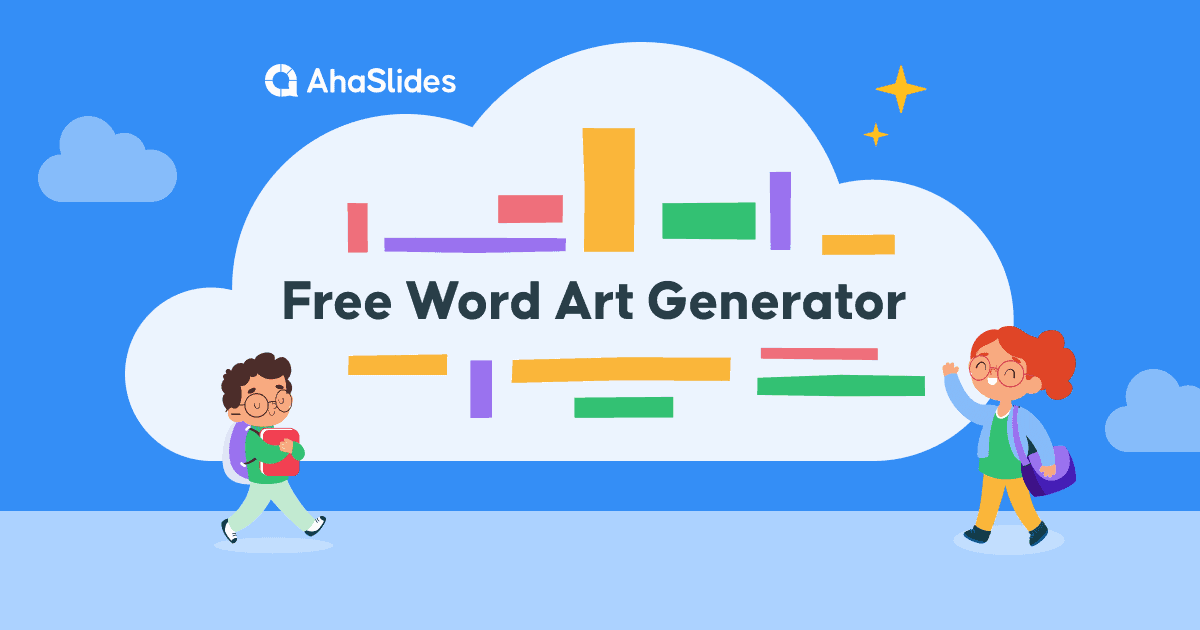If you've ever watched a training session descend into distraction or a team meeting devolve into silence, you've met the attention gremlin. It's that invisible force that makes audiences scroll through phones instead of engaging with your presentation.
Collaborative word clouds offer a scientifically-backed solution. Research from the Journal of Educational Technology shows that interactive elements can increase audience retention by up to 65% compared to passive presentations. These tools transform one-way broadcasts into dynamic conversations where every voice contributes to a visual representation of collective intelligence.
This comprehensive guide examines the 7 best collaborative word cloud tools for professional trainers, educators, HR professionals, and business presenters. We've tested features, analysed pricing, and identified the ideal scenarios for each platform.
Word Cloud vs Collaborative Word Cloud
Let's clear something up before we begin. What's the difference between a word cloud and a collaborative word cloud?
Traditional word clouds display pre-written text in visual form. Collaborative word clouds, however, let multiple people contribute words and phrases in real-time, creating dynamic visualisations that evolve as participants respond.
Think of it as the difference between showing a poster and hosting a conversation. Collaborative word clouds turn passive audiences into active participants, making presentations more engaging and data collection more interactive.
In general, a collaborative word cloud not only displays the frequency of words, but is also great for making a presentation or lesson super interesting and transparent.
Why professional presenters choose collaborative word clouds
Immediate feedback visualisation
See audience understanding or misconceptions instantly, allowing trainers to adjust content in real-time rather than discovering knowledge gaps weeks later through assessment data.
Psychological safety
Anonymous contributions create space for honest feedback in team retrospectives, employee engagement surveys, and sensitive discussions where hierarchy might otherwise silence voices.

Inclusive participation
Remote and in-person participants contribute equally, solving the hybrid meeting challenge where virtual attendees often feel like second-class participants.
You've probably figured this out yourself, but these examples are simply impossible on a one-way static word cloud. On a collaborative word cloud, however, they can delight any audience and pool focus where it should be - on you and your message.
7 Best Collaborative Word Cloud Tools
Given the engagement that a collaborative word cloud can drive, it's no wonder that the number of word cloud tools has exploded in recent years. Interaction is becoming key in all walks of life, and collaborative word clouds are a massive leg-up.
Here are 7 of the best:
1. AhaSlides
✔ Free
AhaSlides stands apart with AI-powered smart grouping that clusters similar responses—transforming "great", "excellent", and "awesome" into a single insight rather than scattered words. The platform balances professional polish with approachable design, avoiding both corporate sterility and childish aesthetics.

Standout features
- AI smart grouping: Automatically consolidates synonyms for cleaner visualisations
- Multiple entries per participant: Capture nuanced thoughts, not just single-word reactions
- Progressive revelation: Hide results until everyone submits, preventing groupthink
- Profanity filtering: Keep professional contexts appropriate without manual moderation
- Time limits: Create urgency encouraging quick, instinctive responses
- Manual moderation: Delete inappropriate entries if filtering misses context-specific issues
- Self-paced mode: Participants join and contribute asynchronously for workshops spanning multiple days
- Brand customisation: Match word clouds to corporate colours, presentation themes, or event branding
- Comprehensive reporting: Download participation data, export responses, and track engagement metrics over time
Limitations: The word cloud is limited to 25 characters, which can be an inconvenience if you want participants to write longer inputs. A workaround for this is to choose the open-ended slide type.
2. Beekast
✔ Free
Beekast delivers a clean, professional aesthetic with large, bold fonts that make every word clearly visible. It's particularly strong for business environments where a polished appearance matters.
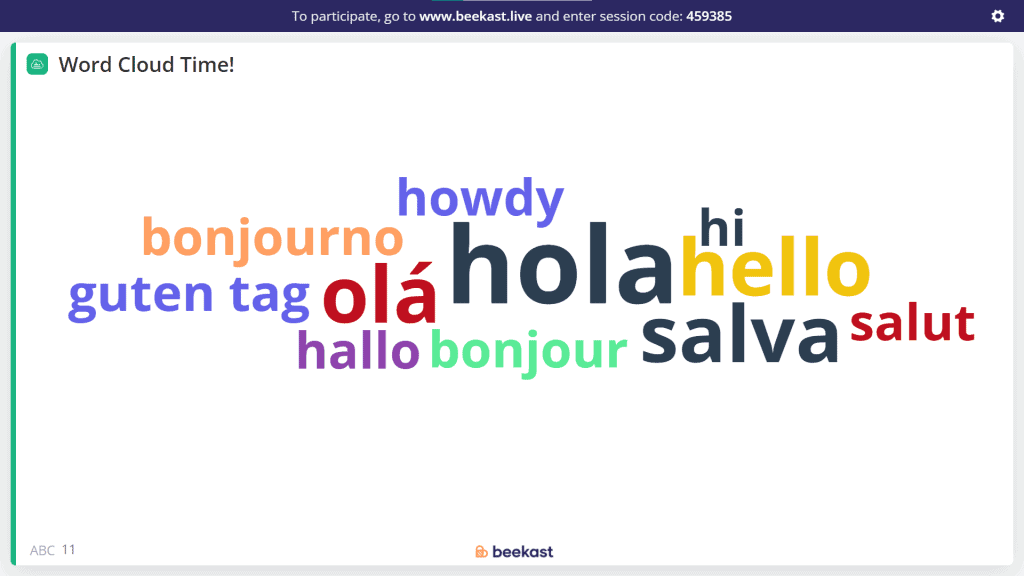
Key strengths
- Multiple entries per participant
- Hide words until submissions have finished
- Allow audience to submit more than once
- Manual moderation
- Time limit
Considerations: The interface can feel overwhelming initially, and the free plan's 3-participant limit is restrictive for larger groups. However, for small team sessions where you need professional polish, Beekast delivers.
3. ClassPoint
✔ Free
ClassPoint functions as PowerPoint plugin rather than standalone platform, making it the lowest-friction option for educators who live in PowerPoint. The installation process takes under two minutes, and the learning curve barely exists for anyone familiar with PowerPoint's ribbon interface.

Key strengths
- Zero learning curve: If you can use PowerPoint, you can use ClassPoint
- Student names visible: Track individual participation, not just aggregate responses
- Class code system: Students join via simple code, no account creation required
- Gamification points: Award points for participation, visible on leaderboard
- Save to slides: Insert final word cloud as PowerPoint slide for future reference
Trade-offs: Appearance customisation limited; locked into PowerPoint ecosystem; fewer features than standalone platforms
4. Slides With Friends
✔ Free
Slides With Friends brings playful energy to virtual meetings without sacrificing functionality. The platform was purpose-built for remote teams, showing in thoughtful touches like avatar systems that make participation visible and sound effects that create shared experience despite physical distance.
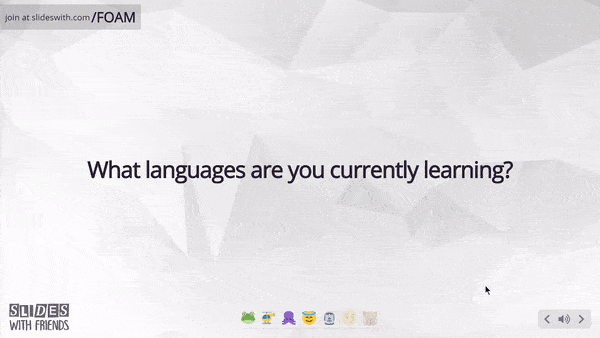
Standout features
- Avatar system: Visual indication of who submitted, who hasn't
- Soundboard: Add audio cues for submissions, creating ambient energy
- Ready-to-play decks: Pre-built presentations for common scenarios
- Voting feature: Participants vote on submitted words, adding second interaction layer
- Image prompts: Add visual context to word cloud questions
Limitations: The word cloud display can feel cramped with many responses, and colour options are limited. However, the engaging user experience often outweighs these visual constraints.
5. Vevox
✔ Free
Vevox takes deliberately serious approach to audience response, resulting in platform that looks at home in board rooms and formal training settings. The 23 different themes offer surprising customisation for occasions from product launches to memorial services—though the interface pays price for formality with steeper learning curve.
Standout features:
- 23 themed templates: Match tone to occasion, from celebratory to solemn
- Multiple entries: Participants can submit multiple words
- Activity structure: Word clouds exist as discrete activities, not presentation slides
- Anonymous participation: No login required for participants
- Image prompts: Add visual context (paid plan only)
Limitations: Interface feels less intuitive than newer competitors; colour schemes can make individual words harder to distinguish in busy clouds
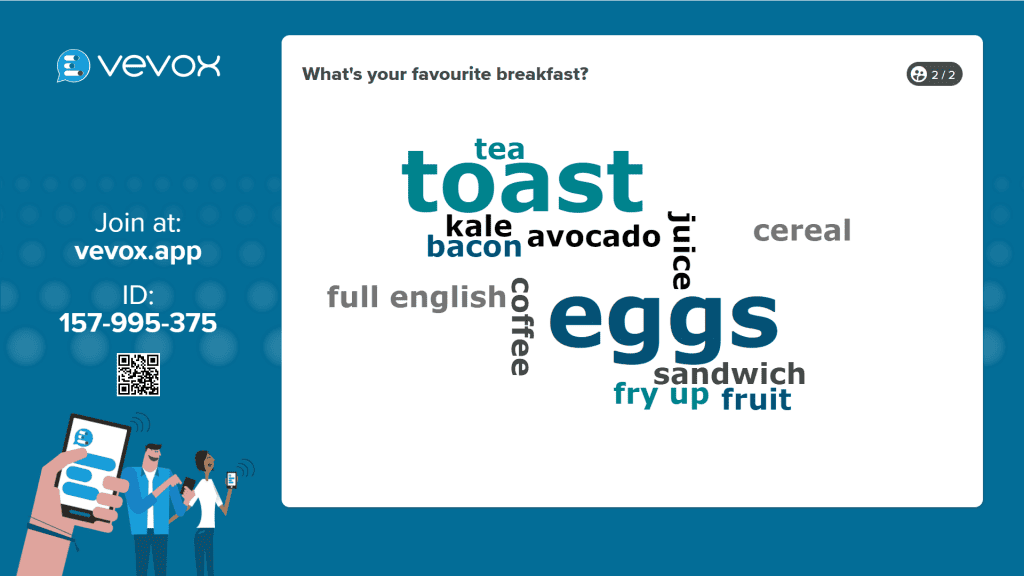
6. LiveCloud.online
✔ Free
LiveCloud.online strips word clouds to absolute essentials: visit the site, share the link, collect responses, export results. No account creation, no feature confusion, no decisions beyond the question you ask. For situations where simplicity trumps sophistication, nothing beats LiveCloud's straightforward approach.
Standout features
- Zero barrier: No registration, installation, or configuration
- Link sharing: Single URL participants visit
- Whiteboard export: Send completed cloud to collaborative whiteboards
- Instant start: From idea to collecting responses in under 30 seconds
Limitations: Minimal customisation; basic visual design; all words similar size/colour making busy clouds hard to parse; no participation tracking
7. Kahoot
✘ Not Free
Kahoot brings its signature colourful, game-based approach to word clouds. Known primarily for interactive quizzes, their word cloud feature maintains the same vibrant, engaging aesthetic that students and trainees love.
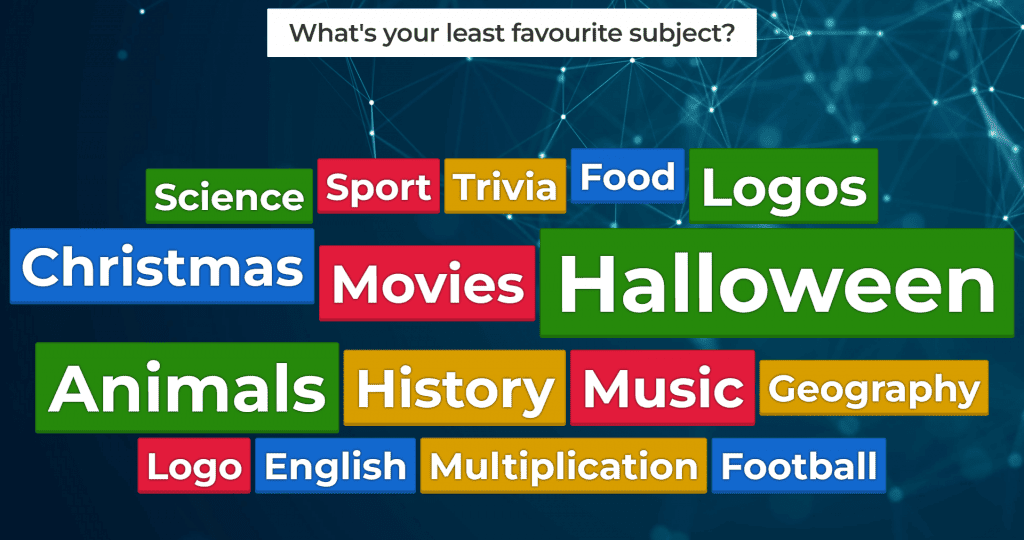
Key strengths
- Vibrant colours and game-like interface
- Gradual reveal of responses (building from least to most popular)
- Preview functionality to test your setup
- Integration with broader Kahoot ecosystem
Important note: Unlike the other tools on this list, Kahoot's word cloud feature requires a paid subscription. However, if you're already using Kahoot for other activities, the seamless integration might justify the cost.
💡 Need a website similar to Kahoot? We've listed 12 of the best.
Choosing the Right Tool for Your Situation
For Educators
If you're teaching, prioritise free tools with student-friendly interfaces. AhaSlides offers the most comprehensive free features, while ClassPoint works perfectly if you're already comfortable with PowerPoint. LiveCloud.online is excellent for quick, spontaneous activities.
For Business Professionals
Corporate environments benefit from polished, professional appearances. Beekast and Vevox offer the most business-appropriate aesthetics, while AhaSlides provides the best balance of professionalism and functionality.
For Remote Teams
Slides With Friends was built specifically for remote engagement, while LiveCloud.online requires zero setup for impromptu virtual meetings.
Making Word Clouds More Interactive
The most effective collaborative word clouds go beyond simple word collection:
Progressive revelation: Hide results until everyone has contributed to build suspense and ensure full participation.
Themed series: Create multiple related word clouds to explore different aspects of a topic.
Follow-up discussions: Use interesting or unexpected responses as conversation starters.
Voting rounds: After collecting words, let participants vote on the most important or relevant ones.
The Bottom Line
Collaborative word clouds transform presentations from one-way broadcasts into dynamic conversations. Choose a tool that fits your comfort level, start simple, and experiment with different approaches.
Also, grab some free word cloud templates below, our treat.
Frequently Asked Questions
What's the difference between a word cloud generator and a collaborative word cloud tool?
Traditional word cloud generators visualise existing text by analysing documents, articles, or pre-written content. You input text, the tool creates a cloud showing word frequency.
Collaborative word cloud tools enable real-time audience participation. Multiple people submit words simultaneously via their devices, creating dynamic clouds that grow as responses arrive. The focus shifts from analysing existing text to collecting and visualising live input.
Do participants need accounts or apps?
Most modern collaborative word cloud tools work via web browser—participants visit a URL or scan a QR code, no app installation required. This reduces friction significantly compared to older tools requiring downloads.

